Chem 104 kinetics exam Study guides, Class notes & Summaries
Looking for the best study guides, study notes and summaries about Chem 104 kinetics exam? On this page you'll find 10 study documents about Chem 104 kinetics exam.
All 10 results
Sort by
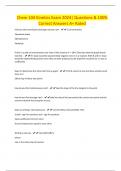
-
Chem 104 Kinetics Exam 2024| Questions & 100% Correct Answers A+ Rated
- Exam (elaborations) • 8 pages • 2024
-
- $11.79
- + learn more
4 factors that contribute to/change reaction rate - 1) concentration 2)reactant phase 3)temperature 4)catalyst if their is a plot of concentration over time of the reaction A--> 2B+C.Describe what the graph would look like. - A's slope would be exponentially negative since it is a reactant. Both B and C's slope would be exponentially positive since they are both products but Bs slope/line would be 2x C's due to coefficients. Steps To determine the initial rate from a graph - 1) Fin...
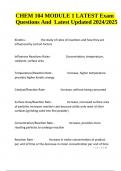
-
CHEM 104 MODULE 1 LATEST Exam Questions And Answers Updated 2024/2025
- Exam (elaborations) • 16 pages • 2024
-
- $14.99
- + learn more
CHEM 104 MODULE 1 LATEST Exam Questions And Answers Updated 2024/2025. Kinetics - the study of rates of reactions and how they are influenced by certain factors Influences Reactions Rates - Concentration, temperature, catalysts, surface area Temperature/Reaction Rate - Increase, higher temperature provides higher kinetic energy Catalyst/Reaction Rate - Increase, without being consumed Surface Area/Reaction Rate - Increase, increased surface area of particles increases reaction rate becau...
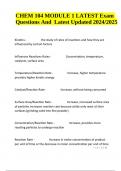
-
CHEM 104 MODULE 1 Exam Questions And Answers Updated 2024/2025 | 100% Correct.
- Exam (elaborations) • 16 pages • 2024
-
- $16.49
- + learn more
CHEM 104 MODULE 1 Exam Questions And Answers Updated 2024/2025 | 100% Correct. Kinetics - the study of rates of reactions and how they are influenced by certain factors Influences Reactions Rates - Concentration, temperature, catalysts, surface area Temperature/Reaction Rate - Increase, higher temperature provides higher kinetic energy Catalyst/Reaction Rate - Increase, without being consumed Surface Area/Reaction Rate - Increase, increased surface area of particles increases reaction ra...
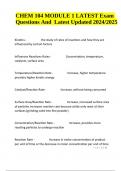
-
CHEM 104 MODULE 1 Exam Questions And Answers Latest Updated 2024/2025 (GRADED)
- Exam (elaborations) • 16 pages • 2024
-
- $14.99
- + learn more
Kinetics - the study of rates of reactions and how they are influenced by certain factors Influences Reactions Rates - Concentration, temperature, catalysts, surface area Temperature/Reaction Rate - Increase, higher temperature provides higher kinetic energy Catalyst/Reaction Rate - Increase, without being consumed Surface Area/Reaction Rate - Increase, increased surface area of particles increases reaction rate because solids only react at their surfaces (grinding solid into fine powde...
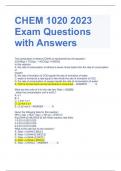
-
CHEM 1020 2023 Exam Questions with Answers
- Exam (elaborations) • 9 pages • 2024
-
Available in package deal
-
- $11.99
- + learn more
CHEM Exam Questions with Answers The combustion of ethane (C2H6) is represented by the equation: 2C2H6(g) + 7O2(g) → 4CO2(g) + 6H2O(l) In this reaction: A. the rate of consumption of ethane is seven times faster than the rate of consumption of oxygen. B. the rate of formation of CO2 equals the rate of formation of water. C. water is formed at a rate equal to two-thirds the rate of formation of CO2. D. the rate of consumption of oxygen equals the rate of consumption of water. E. ...
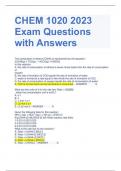
-
CHEM 1020 2023 Exam Questions with Answers
- Exam (elaborations) • 9 pages • 2024
-
Available in package deal
-
- $8.89
- + learn more
CHEM Exam Questions with Answers The combustion of ethane (C2H6) is represented by the equation: 2C2H6(g) + 7O2(g) → 4CO2(g) + 6H2O(l) In this reaction: A. the rate of consumption of ethane is seven times faster than the rate of consumption of oxygen. B. the rate of formation of CO2 equals the rate of formation of water. C. water is formed at a rate equal to two-thirds the rate of formation of CO2. D. the rate of consumption of oxygen equals the rate of consumption of water. E. ...
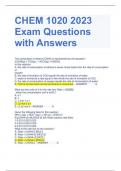
-
CHEM 1020 2023 Exam Questions with Answers
- Exam (elaborations) • 9 pages • 2024
-
Available in package deal
-
- $9.19
- + learn more
CHEM Exam Questions with Answers The combustion of ethane (C2H6) is represented by the equation: 2C2H6(g) + 7O2(g) → 4CO2(g) + 6H2O(l) In this reaction: A. the rate of consumption of ethane is seven times faster than the rate of consumption of oxygen. B. the rate of formation of CO2 equals the rate of formation of water. C. water is formed at a rate equal to two-thirds the rate of formation of CO2. D. the rate of consumption of oxygen equals the rate of consumption of water. E. ...
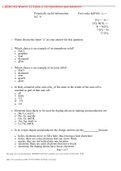
-
CHEM 102 Winter 12 Exam 2 (A) Questions and Answers,100% CORRECT
- Exam (elaborations) • 9 pages • 2023
-
- $14.99
- + learn more
CHEM 102 Winter 12 Exam 2 (A) Questions and Answers Potentially useful information: First order half-life: t1/2 = ln2 / k [A]t = - kt + [A]o ln[A]t = - kt + ln[A]o 1/[A]t = kt +1/[A]o 1. Please choose the letter “a” as your answer for this question. 2. Which choice is an example of an amorphous solid? a. NaCl b. graphite c. iron d. diamond e. glass 3. Which choice is an example of an ionic solid? a. NaCl b. diamond c. iron d. quartz e. glass 4. In body-centered cubi...
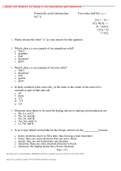
-
CHEM 102 Winter 12 Exam 2 (A) Questions and Answers,100% CORRECT
- Exam (elaborations) • 9 pages • 2023
-
- $14.99
- + learn more
CHEM 102 Winter 12 Exam 2 (A) Questions and Answers Potentially useful information: First order half-life: t1/2 = ln2 / k [A]t = - kt + [A]o ln[A]t = - kt + ln[A]o 1/[A]t = kt +1/[A]o 1. Please choose the letter “a” as your answer for this question. 2. Which choice is an example of an amorphous solid? a. NaCl b. graphite c. iron d. diamond e. glass 3. Which choice is an example of an ionic solid? a. NaCl b. diamond c. iron d. quartz e. glass 4. In body-centered cubi...
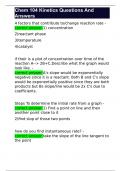
-
CHEM 104 PRACTICE EXAMS BUNDLE WITH A+ SOLUTIONS
- Package deal • 10 items • 2024
-
- $50.49
- + learn more
Chem 104 Kinetics Questions And Answers Chem 104 organic chemistry UW Madison Questions And Answers Chem 104 UW Madison Exam 1 2024 Questions And Answers Chem 104 Module 1 Questions And Answers CHEM 104 EXAM #2 QUESTIONS AND ANSWERS Chem 104 1st exam questions and answers CHEM 104 Exam 4 Questions And Answers Chem 104 exam 3 questions and answers

Do you wonder why so many students wear nice clothes, have money to spare and enjoy tons of free time? Well, they sell on Stuvia! Imagine your study notes being downloaded a dozen times for $15 each. Every. Single. Day. Discover all about earning on Stuvia


